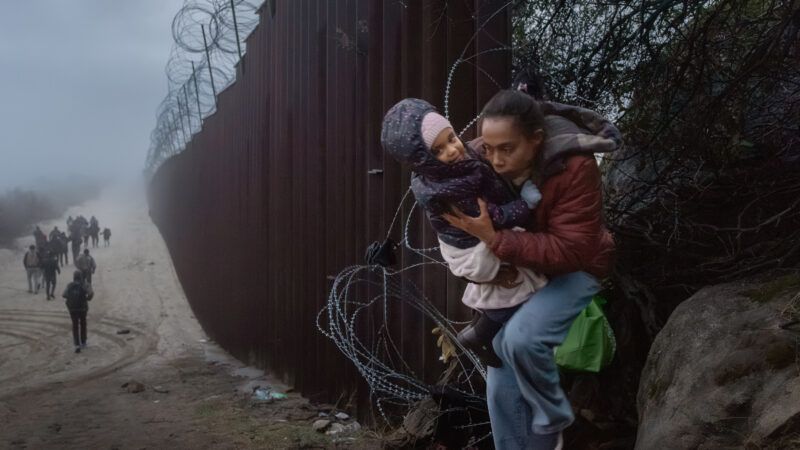'Zero Illegal Crossings' Is an Unattainable Goal for the Border
If House Speaker Mike Johnson really wants less chaos at the border, he should look for ways to make legal immigration more accessible—and more attractive—than illegal immigration.

For the past several months, congressional lawmakers have attempted to forge a bipartisan border security deal. By many indications, that deal is on shaky ground—but that hasn't stopped politicians from voicing some very unrealistic policy goals for the border.
House Speaker Mike Johnson (R–La.) floated one such goal while discussing a deal reportedly struck by a group of senators. "It seems the authority to shut down the border would kick in only after as many as 5,000 illegal crossings happen a day. Why? Why would we do that?" he said on Tuesday. "That would be surrender. The goal should be zero illegal crossings a day."
(The deal would "automatically reject migrants and asylum seekers from crossing the border illegally once the daily average for border crossings surpasses 5,000 over a week or…8,500 on a single day," per Axios.)
President Joe Biden has vowed to "shut down the border when it becomes overwhelmed" if Congress grants him that authority. "I would use it the day I sign" a bipartisan bill "into law," he said. (Former President Donald Trump, meanwhile, has claimed that Biden already has this authority and said that he should get on with using it.)
As good as those promises might sound to border hawks, they're not even remotely feasible. The U.S. government, for all the money and agents it's thrown at the border over the past several decades, has never been able to practically "shut down the border" or achieve zero illegal crossings (all the legal issues with those proposals aside).
Between the creation of the Department of Homeland Security in 2003 and January 2021, the U.S. has spent $333 billion to fund the agencies tasked with immigration enforcement, according to the American Immigration Council, a pro-immigration nonprofit. The budgets for those agencies have been rising for years.
But more enforcement money hasn't necessarily led to lower illegal crossings. As budgets have gone up, apprehensions of people who crossed the border between authorized ports of entry have gone up, down, and remained static. In other words, they don't cleanly align: Though Customs and Border Protection reported 2.05 million apprehensions in FY 2023, it reported somewhat close to that number—over 1.5 million—in FY 2000. Annual apprehensions hovered below 500,000 from FY 2010 through FY 2018.
Tough enforcement doesn't bring illegal crossings down to zero either. Even the pandemic-era Title 42 border order that effectively "closed the border to unauthorized border crossers" and asylum applicants couldn't keep arrivals down, per a January report from the Migration Policy Institute (MPI). "Arrivals at the border increased dramatically through 2021 and 2022, despite the order remaining in place."
A policy brief last May from the National Foundation for American Policy, drawing on 100 years of Border Patrol apprehensions data, found that "none of the three U.S. periods with a significant decline in illegal immigration were due to enforcement policies." Rather, they were due to increased legal pathways as well as changing demographics and labor demand.
The U.S.-Mexico border stretches nearly 2,000 miles, much of it treacherous. No matter the funding and no matter the enforcement mandate, there's no way that agents could stop every illegal crosser traversing the deserts, mountains, and waters that make up the border region. That's proven impossible along much smaller and more surveilled borders, such as the boundaries of East Germany and North Korea.
All this suggests that it's time for some reflection from today's zero-illegal-crossings proponents.
"The contemporary challenge at the southwest border is one of border control rather [than] border security," suggests the MPI. "The national objective must be not to solve the border control challenge by apprehending and removing 100 percent of unauthorized migrants, but rather to manage it in a manner consistent with the law and reasonably satisfactory to the American people."
Any workable border deal should focus on ways to make legal immigration more accessible—and more attractive—than illegal immigration. That's a proven way to reduce illegal crossings and a promising way to ensure that border agents can focus on actual threats rather than the vulnerable migrants who are simply seeking a place to live and work in peace.



Show Comments (173)